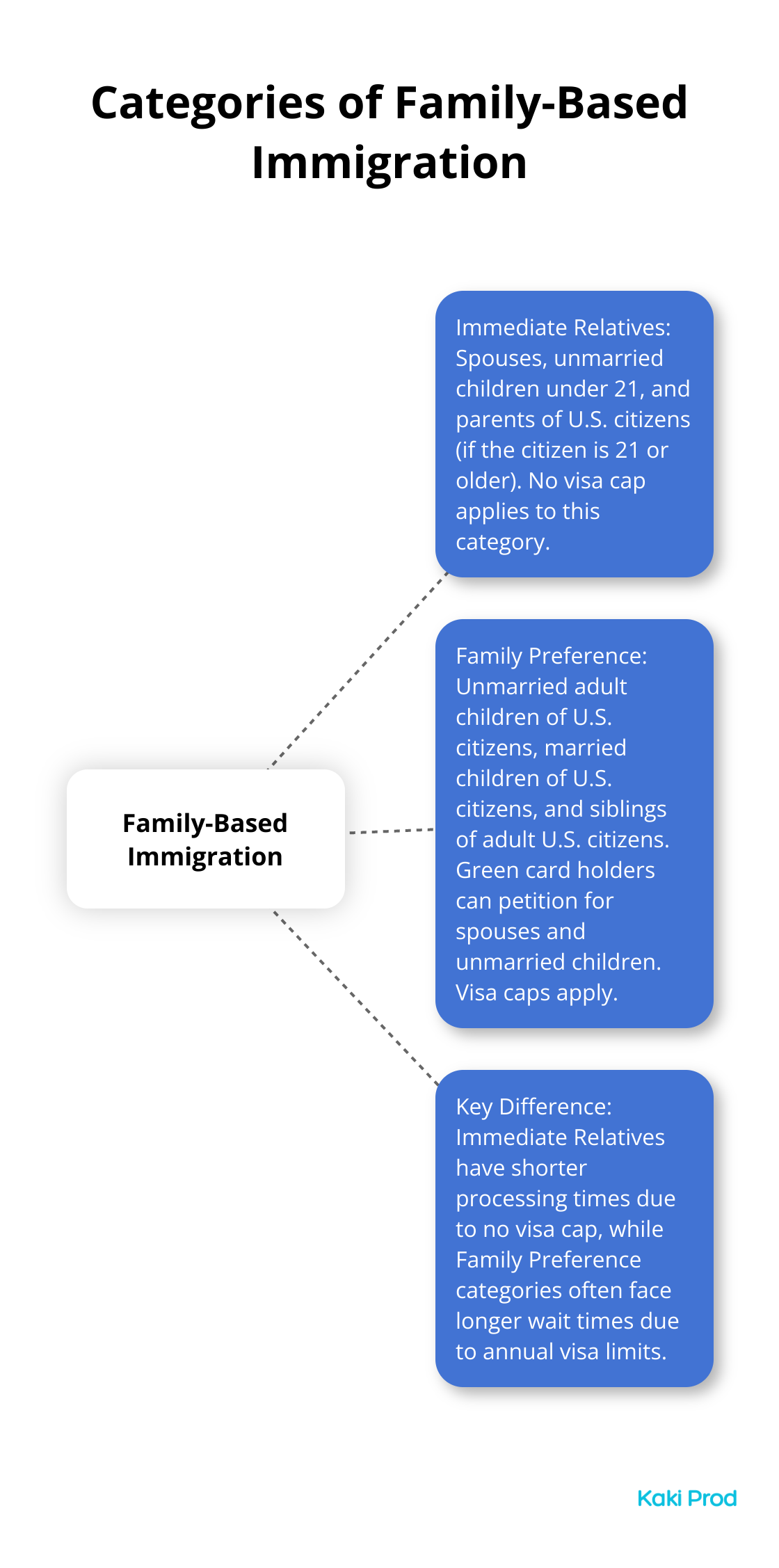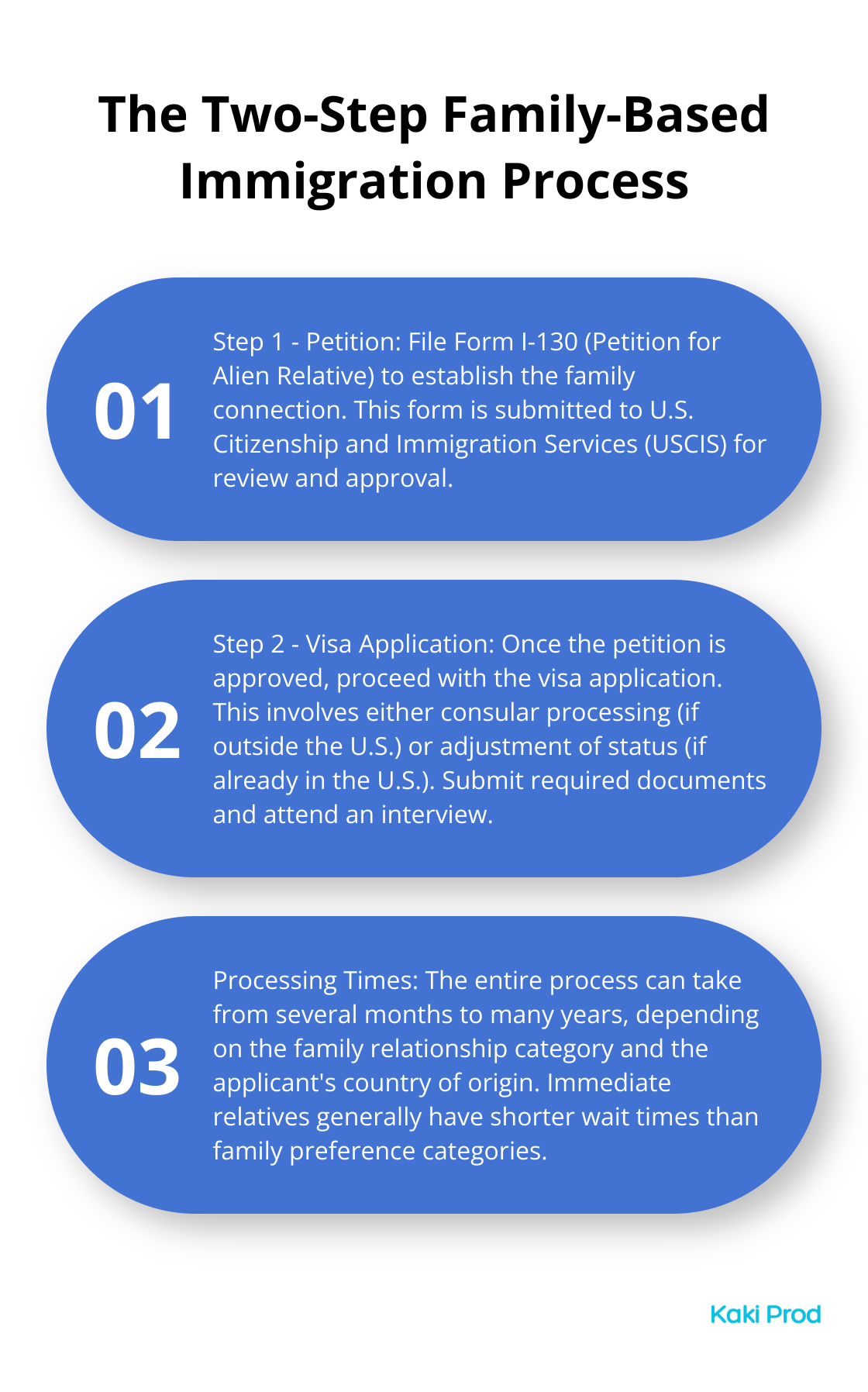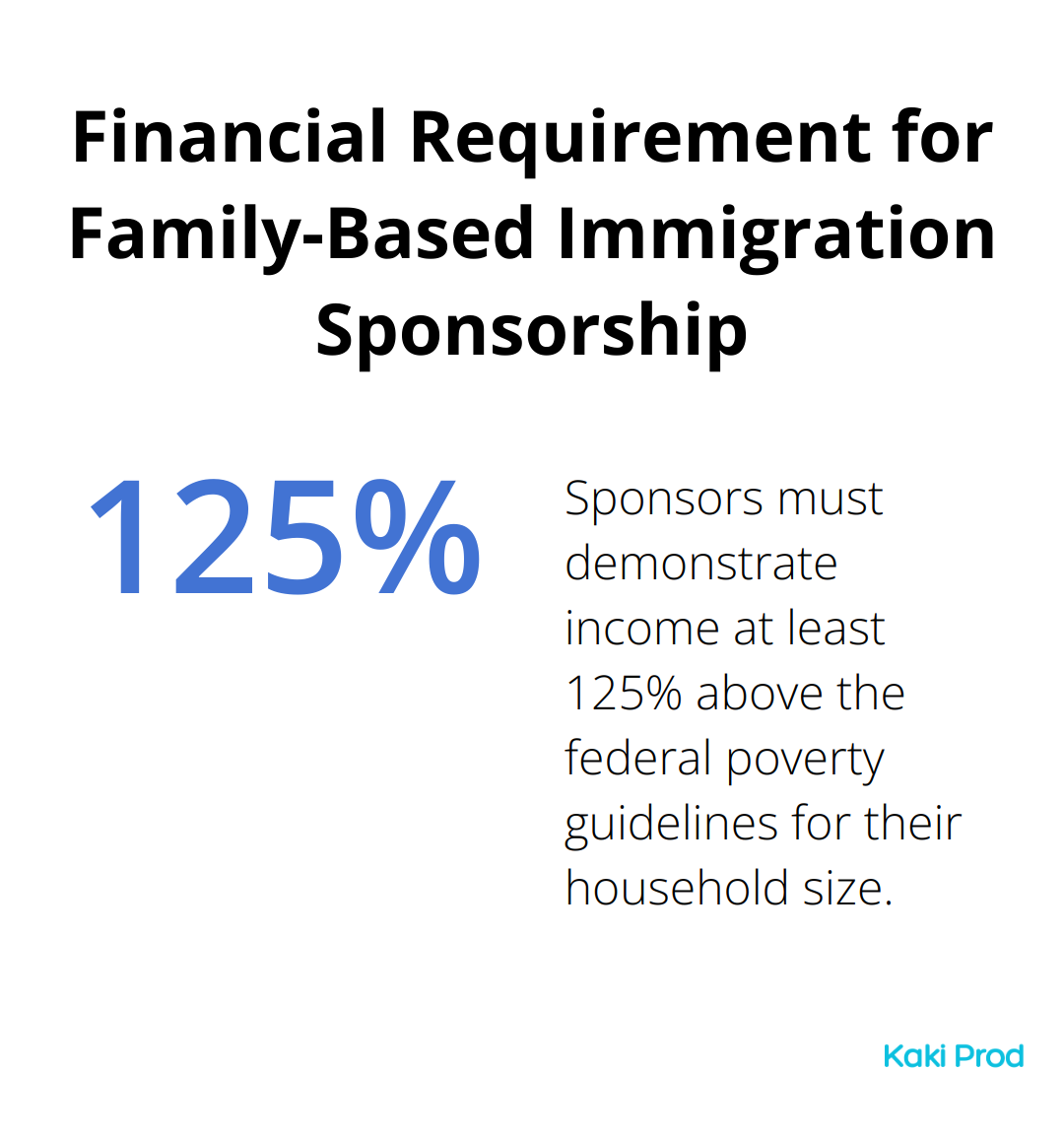Family-based immigration to the U.S. — it’s like untangling a pair of headphones that have been in your pocket for a year. A complex beast, really, but at the heart of it is the mission to reunite loved ones across continents. Oh, the journey — paperwork piling up to the ceiling, waiting times that seem inspired by geological eras, and legal hurdles that make Olympic athletes sweat.
At Kaki Prod, we’ve been around the block — and then some. Guiding countless families through this labyrinthine system is our thing. Dive into our blog post where we slice through the steps, tackle the challenges, and serve up solutions… all to help you conquer the family-based immigration maze with a cool head and maybe even a smile.
What Is Family-Based Immigration?
The Cornerstone of U.S. Immigration Policy
Alright folks, let’s talk about family-based immigration-the bedrock of U.S. immigration policy. It’s a big deal, accounting for a hefty slice of legal permanent immigration into the States. Basically, it’s the ticket for U.S. citizens and lawful permanent residents to get their family tree across the border with green cards in hand.
Eligible Family Relationships
Here’s the rundown: Uncle Sam splits the family connections eligible for a green card into two big buckets.
- Immediate Relatives: This one’s like the express lane. Think spouses, unmarried kids under 21, and of course, parents of U.S. citizens (only if you’re 21 or up, though). No cap on these visas-meaning no fighting over limited seating. The line’s shorter here.
- Family Preference: Okay, here’s the catch-this is where it gets tricky. We’re talking about folks like:
- Unmarried adult children of U.S. citizens
- Married children of U.S. citizens
- Siblings of adult U.S. citizens
Green card holders only get to bring their spouses and unmarried kids. These visas are like your favorite concert-limited tickets-so get ready to wait it out.

The Two-Step Immigration Process
Buckle up, because family-based immigration isn’t exactly a leisurely stroll in the park. It’s more of a marathon with two key stages:
- Petition: Start by filing Form I-130 (Petition for Alien Relative). This is your golden ticket to establishing the whole family connection drama. U.S. Citizenship and Immigration Services (USCIS) gets to vet it for the real deal.
- Visa Application: Once past step one, you’re into the visa application phase. If you’re outside the U.S., it’s consular processing; inside the U.S., you’re looking at adjustment of status. Copies, signatures, and possibly limbo await.
The whole shebang can drag on from mere months to what feels like eons, depending on the family link and where in the globe they’re dialing in from. As of May 2025, siblings of U.S. citizens are in a conga line stretching due to backlog central.
Beyond Paperwork
More than just ink on paper, my friends. It’s a ride-proving who’s who, meeting Uncle Sam’s fiscal expectations, and a legal maze that’d give New York cabbies a run for their money.
Yes, family-based immigration has its ups and downs, but with smart moves and the right guidance, you can crack it. Next up, we break down how to make this journey smoother and get you across the finish line.
How to Navigate the Family-Based Immigration Process
Filing Form I-130: The First Step
So, you’re diving into the family-based immigration world? Your opening act is Form I-130, aka the Petition for Alien Relative. This little guy is what kickstarts the whole shebang, proving you and your family member are, indeed, family. But here’s the kicker-USCIS processing times for I-130 forms can swing wildly from 6 to 24 months (yep, as of May 2025). It all depends on things like how you’re related and USCIS’s current backlog.
Want to dodge delays? Then go over that I-130 with a magnifying glass. Double-check every detail. Attach every required document-birth certificates, marriage licenses, and proof of U.S. citizenship or permanent residency for you, the petitioner. Oh, and by the way, those documents? English only, or bring certified translations along for the ride.

Navigating the Waiting Period
Filed your I-130? Cool. Now comes the part where you wait. But don’t just twiddle your thumbs. Use this time to hustle. Beneficiaries should be gathering documents for the next act-police clearances, medical records, financial docs, you name it. Petitioners need to make sure they meet the financial requirements, ready to sponsor their family member.
The Department of State has all the stats you could want as of November 1, 2023. Patience? Vital. But being proactive now can be your time-saving ally later on.
Choosing Between Visa Application and Adjustment of Status
Got the green light on your I-130? Nice. Next step? Depends on where the beneficiary is hanging out. If they’re outside the U.S., consular processing is their gig-apply for an immigrant visa via the National Visa Center (NVC) and a U.S. embassy or consulate overseas.
Already in the U.S.? Consider adjustment of status (that’s Form I-485 in your inbox). This route could land them a green card without stepping a foot outside the country. But here’s the deal-eligibility here is no joke, so chat with an immigration expert to see if this option is open to you.
Pro tip: Don’t just hang around intending to adjust status on a nonimmigrant visa without a game plan. Overstaying? Huge consequences (think: potential bans from the U.S.).
Acing the Interview
Ah, the interview-a pivotal moment whether you’re at a U.S. consulate somewhere exotic or a down-the-road USCIS office. Study your application front to back. Be ready to chat about your relationship, your history, your American dreams.
For consular processing, flick through the U.S. Department of State stats to psych yourself up. Knock it out of the park, and you’re one step closer to your story making it on that list.
Entering the U.S. and Receiving Your Green Card
Score an approved visa? You’re almost there. Folks outside the U.S. get a sealed visa packet. Hands off! That packet’s for U.S. immigration to open when you hit entry.
Once you’re in, boom-welcome, lawful permanent resident. Your green card will make its snail mail journey a few weeks later. If you’re adjusting status stateside, you’ll nab your green card once your I-485 clears the hurdle.
Family-based immigration might look like a maze, but with solid prep and a guiding hand, you can find your way. But don’t think it’s all over once you clutch that green card. Stay tuned-the next chapter tackles common hurdles in this saga and how to vault over them.
Tackling Family Immigration Hurdles
The Waiting Game
Family-based immigration-it’s like trying to get a table at the hottest restaurant in town. As of May 2025, some folks are waiting like they’re in their twenties. The U.S. Department of State has backlogs that stretch further than that last season of your favorite show. So, what do you do in this lineup?
- Get your paperwork in early and make it watertight. One little slip-up? Boom, there go a few more months from your life.
- Use the USCIS online magic checker-frequently. Keep your pulse on that case, like checking your phone for the latest meme.
- If you’ve out-waited the norm, ring up your congressman’s office. They might be able to kick it into high gear.
Proving Your Relationship
USCIS and the consular team are like hawks when it comes to your family ties-they’re on the lookout for any funny business. Proof is the name of the game, my friends.
For married folks, you need more than just the “I do” papers. We’re talking joint bank accounts, leases with both your names, and a timeline of photos. Sponsoring a parent or sib? Birth certificates, sure, but add some family selfies, chat logs, and if you’ve got a doozy on your hands, maybe some DNA results.
Start building that digital evidence stockpile-think of it as your relationship insurance policy. Better too much than coming up short when it counts.
Financial Requirements
The Affidavit of Support (Form I-864)-that’s your golden ticket to prove Uncle Sam won’t be footing the bill for your relative’s Charmin. By 2025, you’ve got to show your income is 125% above the federal poverty guidelines for your household size.
Not hitting that mark? Consider these hacks:
- Use your assets to patch that income gap
- Rope in a joint sponsor
- Hustle some part-time work
- Raid the retirement account piggy bank (if you’re feeling bold)
This is a legally binding gig. You’re on the hook for your relative until they’re either waving a citizen flag or clocking in 40 quarters of work on U.S. soil.

Addressing Inadmissibility Issues
Got skeletons in the closet-immigration violations, a dodgy past, or a health hiccup? Don’t fret, many inadmissibility woes have get-out-of-jail-free cards, aka waivers.
Take unlawful presence, for instance, and the dreaded 3 or 10-year bar from the U.S. There’s room for redemption if you can prove a U.S. citizen or permanent resident spouse or parent would suffer epic hardship without you.
Be straight up about any issues-hiding the dirt will just make a bigger mess later. Bring an immigration attorney onto your team. They’ve got the playbook for tackling these problems and scouting out waiver options.
Final Thoughts
Family-based immigration to the U.S. – it’s a marathon, not a sprint. You need a truckload of patience, a treasure trove of prep, and the dogged determination of, well, a dog going after a bone. We’re talking steps within steps here, folks – from the initial I-130 blues to jumping through the hoops of visa applications, and let’s not forget those roadblocks that make you wanna bang your head against a wall. Every phase is a checklist lover’s dream (or nightmare) and requires you to be as detailed as a Swiss watchmaker (minus the tiny gears).
At Kaki Prod, we totally get how navigating the family-based immigration maze can feel like playing 4D chess while juggling chainsaws. Our platform is your compass through this bureaucratic wilderness. We’re talking resources galore and insider know-how – everything you need to zigzag your way through the U.S. immigration labyrinth. Plus, we’ve got your back with life hacks for your new American adventure – from personal growth secrets to career climbing tips (because why not knock down a few ceilings while you’re at it?).
Visit our website for the lowdown on this crazy ride called the immigration journey and everything that follows. Sure, bringing your clan over through immigration is like trying to solve a Rubik’s Cube while blindfolded, but hey, countless folks have pulled it off. With the right road map and a stash of support, those stars might just align – and boom, the land of the free here you come, with your loved ones in tow.

